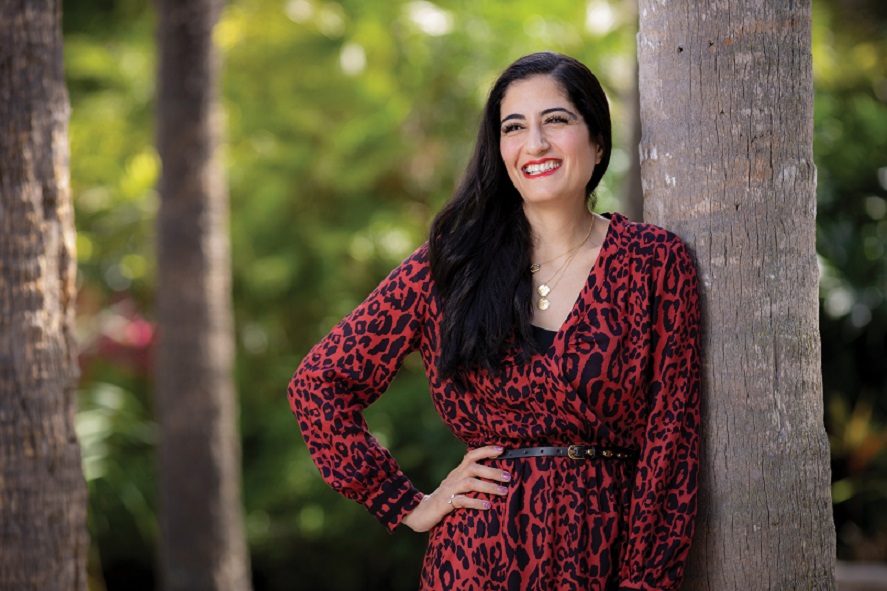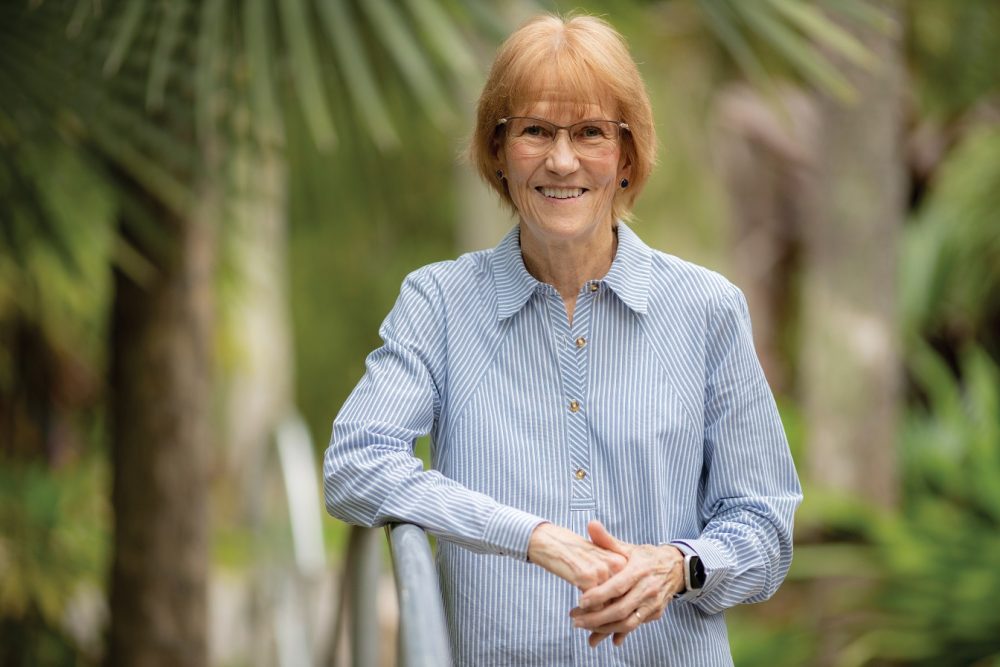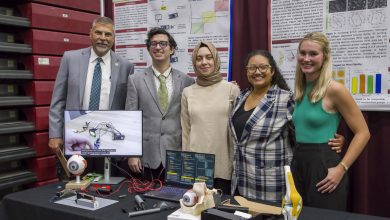Women in STEM: What Has Changed? What Hasn’t? What Now?
While American society has seen considerable improvement in female representation in the science, technology, engineering and mathematics fields, gender parity in STEM remains elusive. What has changed? What hasn’t? And, most important, where do we go from here?
When Shermineh Fairchild walked into Florida Tech’s administration office to interview for an assistant professorship in the department of aerospace, physics and space sciences, she was pleasantly surprised.
Greeting her was a room full of women. Not just any women: Female scientists. In leadership roles. Wearing bright colors. Smiling.

Having grown up a young girl in Iran, where a rigid education system and legal discrimination based on gender, beliefs and appearances limit women’s professional advancement opportunities, this was the stuff of dreams.
“It was just a breath of fresh air,” Fairchild says, and she accepted the position weeks later.
Unfortunately, even in the United States, professional female leaders in the science, technology, engineering and mathematics (STEM) fields are few.
People debate how it happened, how to fix it and even if it matters. But on one fact, there is no debate: Women are underrepresented in STEM fields.
While, according to the National Center of Education Statistics, they have consistently earned about 57% of the bachelor’s degrees awarded in the U.S. for the last 18 years, women are earning only about 36% of those in STEM disciplines.
Of those who earn STEM degrees, even fewer work in the field, with almost half of women leaving STEM occupations within a decade—close to twice the frequency of their male counterparts—and women hold only about 18% of STEM leadership roles.
“Now that I’m a ‘woman in STEM,’ there is a big pressure to succeed,” Fairchild says. “In society’s eyes, when I fail, it’s not just my failure—it’s a reflection of all women. There shouldn’t be that pressure.”
But as any good scientist knows, to solve a problem, you must first understand its origins.
It’s all about perception.
Girls play with dolls.
Boys play with building blocks.
Many believe that stereotypes like these are at the root of the problem.
Research shows that “gender socialization,” or the learned social expectations associated with one’s sex, begins at a young age. Traditionally, these mentalities include stereotypes that males excel at math and science and females are better in the social sciences, despite research evidence to the contrary.
These gender stereotypes shape girls’ attitudes toward and confidence in math and science and ultimately decrease their interest in STEM fields.
Likewise, although society has made strides in equalizing the general workforce, with women making up about 47% of U.S. laborers, stereotypes based on traditional gender roles—men working outside the home and women running the household—persist.
Anika Ahmed ’17 was born in Bangladesh and lived there until she came to Florida Tech to study aerospace engineering in 2014.

“I come from a brown culture where girls aren’t encouraged, and I took it personal from the very beginning,” Ahmed says. “All my male friends were getting encouraged to pursue big careers, and we were being groomed for housework.”
Despite significantly better conditions comparatively, Ahmed still recognizes gender stereotypes being consciously and subconsciously reinforced in U.S. schools, homes and society.
From dress-up clothes and tea sets instead of Legos and sports equipment to compliments about their pretty appearances instead of their clever ideas, what young girls are given, they internalize.
So, Ahmed is giving them something different: Girls Who Code.
Girls Who Code is an international nonprofit organization that, through free after-school, campus and summer programs, teaches young girls about computer science, careers in STEM fields, analytical skills and, most important, confidence.
“With education, the things they can do—incredible. They need to hear it more,” Ahmed says.
Having launched in November 2018, Ahmed’s Girls Who Code Florida Tech chapter’s first class includes 11 fifth- and sixth-grade girls. The key, Ahmed says, is the program’s structure. With concrete lesson plans, a proven curriculum and an established textbook, she needs only to arrange for skilled tutors to facilitate the classes.
“I want to work toward the education of young girls and to break those barriers for them, so they don’t look at it as something boys do,” Ahmed says. “They can do it, and they can excel.”
In the field
Today, a growing number of women overcome that gender socialization and decide to pursue STEM careers. Unfortunately, not all people can so easily relinquish the societal stereotypes ingrained in them.
“I really think the main problem is that people—even other women, unfortunately—don’t take you seriously or as seriously as they take a man in the same position,” Fairchild says.
Recent biomedical engineering graduate Jennifer Berg ’19 agrees.

“I think a common challenge is not feeling validated as an engineer or a scientist,” Berg says. “When you speak up or when you try to give your opinion, it’s going to be criticized a lot more harshly, and when you make a mistake, it’s going to be judged a lot worse.”
This discrimination results not only in women’s lost research collaborations, presentation opportunities and promotion prospects, but also in a voided sense of the group belonging that humankind inherently seeks.
In fact, research shows that a key measure of positive versus negative experiences is acceptance within one’s peer group.
“You’re willingly going into a field where you know you’re going to be a minority,” Berg says. ”It’s difficult getting out of your comfort zone, and that could be a hesitation for some girls wanting to go into STEM.”
Berg finds comfort in the biomedical engineering program’s about 50-50 male-to-female ratio, but her four years studying alongside STEM peers have not been without seclusion.
During an automotive engineering internship, Berg was the only woman on her team and one of only four female engineering interns at the company that summer.
“Having other females to support and empower each other is a very helpful thing when you’re trying to go to college or build a career,” Berg says. “Females don’t always get the opportunity to form that kind of support circle, which I think is beneficial to have, regardless of if you’re an engineer.”
So true to engineering form, if it doesn’t occur naturally, they build it themselves.
Women in STEM groups serve multiple purposes, from providing a sense of camaraderie and establishing a network of peers and mentors to developing strategies for a more equitable workforce, cultivating the next generation of professional STEM women and sending a very clear, very important message: It can be done.
“It’s hard for me to imagine myself as a CEO, because there aren’t many women CEOs leading Fortune 500 companies—or any companies—so that’s something we want to work toward,” Ahmed says.
As home to a diverse group of female STEM students, faculty, staff and alumni, Florida Tech is a hub for such collaboration, taking form in campus clubs like Launch STEM Careers, the Women in STEM group and the Society of Women Engineers (SWE).
These organizations sponsor female-empowerment initiatives through volunteer work, hosting STEM-exploration events, summer camps, interactive science experiments and mentorship programs for school-aged girls, as well as professional networking seminars featuring mock interviews, inspirational speakers, advisement opportunities and job and internship fairs for college women.
In January, Harris Corp. hosted Florida Tech’s Women in STEM group at its Global Innovation Center, where members interacted with female Harris executives and learned about their career paths, explored Harris’ defense communication innovations and discussed potential internship opportunities.
“It’s all to encourage young girls going into STEM and sparking their interest to show them, ‘Hey, we’re doing STEM, and you can do it, too,’” says Berg, who served as president of the SWE Florida Tech chapter. “It’s about having a community—a support system.”
Events and organizations such as these also serve to break down a stereotype that transcends gender differences.
“The general public thinks of scientists and engineers as very serious, one-dimensional people without many social skills or a life outside of work,” Fairchild says. “The stereotype has existed for so long, it’s hard to change it. But if we want to see a big change, we have to show people that you don’t need to fit into that cliché to succeed.”
Is it working?
Florida Tech first lady and University Research Professor Mary Helen McCay thinks so.
Her almost 60-year career in STEM began as a freshman engineering science student at Florida State University, where she was the only female engineering student at the time and was told by a professor at orientation, “You’ll be in home ec. by the end of the term.”
From her days as a payload specialist astronaut alternate to her current role as head of Florida Tech’s National Center for Hydrogen Research, McCay has watched the environment for women in STEM fields evolve.

“I feel really good about it,” McCay says. “I’m incredibly impressed with what Florida Tech is doing. I just want to tell them to keep going; keep doing what you’re doing.”
Aside from the continually increasing number of clubs, organizations and events encouraging women in STEM fields, Florida Tech’s student, faculty and staff populations reflect increased diversity, too.
In the last 20 years, the number of females earning graduate and undergraduate degrees in STEM fields has almost doubled, with a 73% increase in just the last 10 years, and the total number of women earning graduate and undergraduate degrees has increased 140% in the same time period. Even more promising, 91% of women who in 2017 graduated with degrees in STEM fields reported working in their field of study six months after graduation.
Likewise, the percent of female instructional faculty members at Florida Tech has grown by 12% since 2000, and women like McCay, Senior Vice President for Research Gisele Bennett, Senior Vice President for Academic Administration Monica Baloga, Associate Provost Mary Bonhomme and others serve in prominent leadership roles on campus.
“At this point, it’s almost pandemic,” Ahmed says. “The more we talk about it, the more we address the issue and work toward it, the faster we’ll reach the point where everything is neutral—there’s no minority or discrimination.”
However, topics like affirmative action, equal pay, workplace harassment and corporate policies like maternity leave remain points of public debate. And still, some ask:
Does it matter?
Simply put, yes.
The U.S. Department of Labor projects millions of STEM-field job openings will need to be filled—whether by men or women—in the coming decade.
Ninety-three out of 100 occupations in STEM fields report wages higher than the national average. More women in these lucrative positions would mean a narrowed gender pay gap and increased female financial independence.
“Unfortunately, a lot of women are trying to think more like men and feel like, in order to survive in the field, they need to take on more of the male traits,” McCay says. “But I happen to think we have a lot to offer on our side. We’re complementary, and we all just need to learn to work with each other, together.”
This story was featured in the Spring 2019 Edition of the Florida Tech Magazine.






